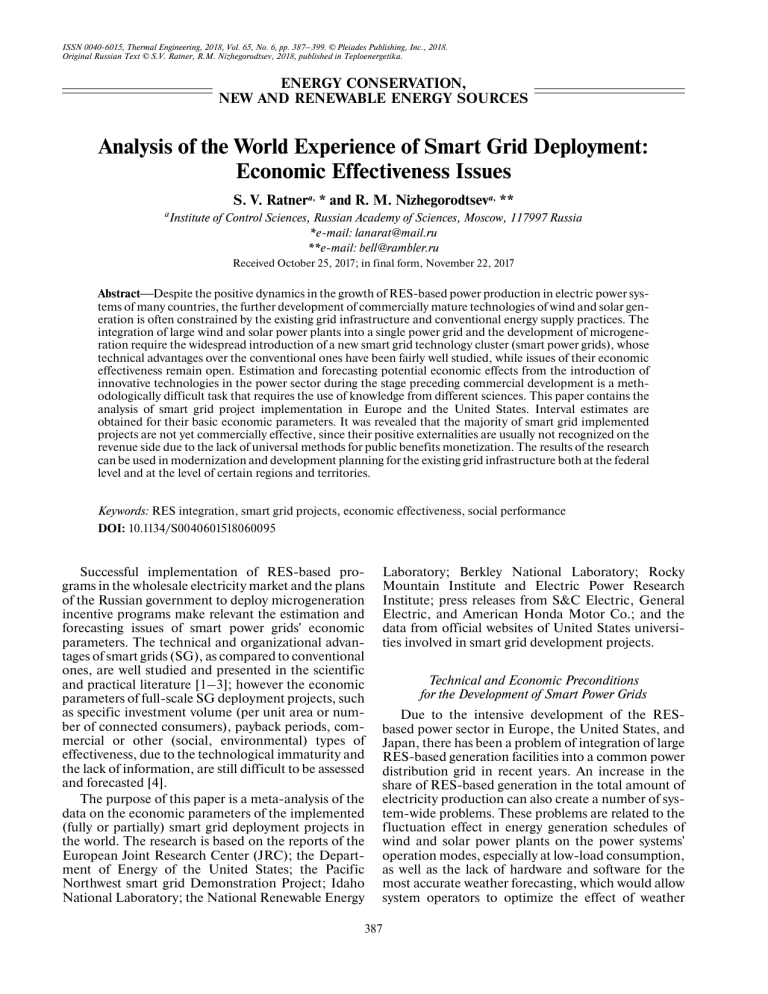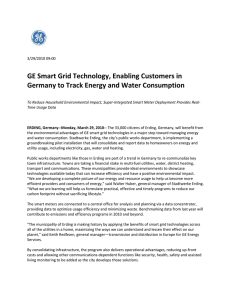Analysis of the World Experience of Smart Grid Deployment: Economic Effectiveness Issues
advertisement

ISSN 0040-6015, Thermal Engineering, 2018, Vol. 65, No. 6, pp. 387–399. © Pleiades Publishing, Inc., 2018. Original Russian Text © S.V. Ratner, R.M. Nizhegorodtsev, 2018, published in Teploenergetika. ENERGY CONSERVATION, NEW AND RENEWABLE ENERGY SOURCES Analysis of the World Experience of Smart Grid Deployment: Economic Effectiveness Issues S. V. Ratnera, * and R. M. Nizhegorodtseva, ** a Institute of Control Sciences, Russian Academy of Sciences, Moscow, 117997 Russia *e-mail: lanarat@mail.ru **e-mail: bell@rambler.ru Received October 25, 2017; in final form, November 22, 2017 Abstract⎯Despite the positive dynamics in the growth of RES-based power production in electric power systems of many countries, the further development of commercially mature technologies of wind and solar generation is often constrained by the existing grid infrastructure and conventional energy supply practices. The integration of large wind and solar power plants into a single power grid and the development of microgeneration require the widespread introduction of a new smart grid technology cluster (smart power grids), whose technical advantages over the conventional ones have been fairly well studied, while issues of their economic effectiveness remain open. Estimation and forecasting potential economic effects from the introduction of innovative technologies in the power sector during the stage preceding commercial development is a methodologically difficult task that requires the use of knowledge from different sciences. This paper contains the analysis of smart grid project implementation in Europe and the United States. Interval estimates are obtained for their basic economic parameters. It was revealed that the majority of smart grid implemented projects are not yet commercially effective, since their positive externalities are usually not recognized on the revenue side due to the lack of universal methods for public benefits monetization. The results of the research can be used in modernization and development planning for the existing grid infrastructure both at the federal level and at the level of certain regions and territories. Keywords: RES integration, smart grid projects, economic effectiveness, social performance DOI: 10.1134/S0040601518060095 Successful implementation of RES-based programs in the wholesale electricity market and the plans of the Russian government to deploy microgeneration incentive programs make relevant the estimation and forecasting issues of smart power grids' economic parameters. The technical and organizational advantages of smart grids (SG), as compared to conventional ones, are well studied and presented in the scientific and practical literature [1–3]; however the economic parameters of full-scale SG deployment projects, such as specific investment volume (per unit area or number of connected consumers), payback periods, commercial or other (social, environmental) types of effectiveness, due to the technological immaturity and the lack of information, are still difficult to be assessed and forecasted [4]. The purpose of this paper is a meta-analysis of the data on the economic parameters of the implemented (fully or partially) smart grid deployment projects in the world. The research is based on the reports of the European Joint Research Center (JRC); the Department of Energy of the United States; the Pacific Northwest smart grid Demonstration Project; Idaho National Laboratory; the National Renewable Energy Laboratory; Berkley National Laboratory; Rocky Mountain Institute and Electric Power Research Institute; press releases from S&C Electric, General Electric, and American Honda Motor Co.; and the data from official websites of United States universities involved in smart grid development projects. Technical and Economic Preconditions for the Development of Smart Power Grids Due to the intensive development of the RESbased power sector in Europe, the United States, and Japan, there has been a problem of integration of large RES-based generation facilities into a common power distribution grid in recent years. An increase in the share of RES-based generation in the total amount of electricity production can also create a number of system-wide problems. These problems are related to the fluctuation effect in energy generation schedules of wind and solar power plants on the power systems' operation modes, especially at low-load consumption, as well as the lack of hardware and software for the most accurate weather forecasting, which would allow system operators to optimize the effect of weather 387 388 RATNER, NIZHEGORODTSEV conditions on generation and load schedules. Study [5] shows that, if the share of wind in power generation reaches 15–20% of the installed power system capacity, wind power plants' power fluctuations can negatively affect the dynamic stability of power systems. In 2016, solar power in the European Union covered 4% of the total demand for electricity, and the share of energy generated by solar power plants could vary from 5.2 to 7% of the total electricity production by 2020 [6]. This share is already much higher in some countries: according to data for 2015, the solar power generation accounted for 8% of the total electricity production in Italy, while it accounted for 7% in Greece and Germany according to data for 2016. The share of wind power in the total electricity production in 2016 accounted for 10.4% in the European Union, approximately 6% in Canada, 5.5% in the United States, and 3.3% in China [7]. The world leader in the development of wind power engineering is Denmark. Thus, 37.6% of the total electricity production in the country in 2016 was by wind power. The Danish government plans to achieve 50% of wind power penetration into power generation by 2020. Thus, many EU countries have even now come close to or even surpassed the 15% share of RES in the total generation; thus, the further increase in the level of penetration of renewable energy into power generation is significantly constrained by the technological level of the existing grid infrastructure. However, increasing interest in smart grids, both from power engineers and investors, can be explained not only by RES development problems and the need to improve the reliability and quality of energy supply. According to forecasts of American experts, the smart grid equipment market and deployment projects could grow in the United States in the next 10 years up to $60 billion US dollars and up to $240 billion US dollars in the world market [8]. Smart grid technologies currently have formed several adjacent high-tech markets, so their development in the future could bring significant profits to manufacturers of various types of electrical equipment and developers of algorithmic procedures and software, standards and protocols. Therefore, many technologically advanced countries actively support the deployment of smart grids through various incentive state programs [9, 10]. State Incentive Programs for the Development of Smart Grids in the European Union and the United States From 2008 to 2016, 140 projects were implemented in the United States within the state incentive smart grid deployment program [11]. The total scope of financing of these projects from the federal budget (through the United States Department of Energy) exceeded $4 billion US dollars. In the European Union, 950 projects were implemented within approximately the same time period, with the total investments of up to 5 billion euros [12, 13]. All the Euro- pean projects are classified by the life-cycle stage into research projects, providing for the development and testing of new technologies, and demonstration projects, which are used in practice to show potential consumers new technology capabilities. Research projects (57%) prevail in the total number, while their share (only 32%) in the total investment volume is behind the share of demonstration projects (68%). There is a slightly different project classification in the United States, based not on the life-cycle stage but on the main purpose of the project implementation. There are three main types of projects [11], such as: (1) RES-based and distributed sources integration projects (Renewable and Distributed System Integration Program (RDSI)); (2) Demonstration projects (smart grid Demonstration Program (SGDP)); (3) Investment projects (smart grid Investment Grant Program (SGIG)). Each of the three types of projects has a very significant research component and is financed primarily from the federal budget (Fig. 1); however, in terms of budgetary investments, the RES-based and other distributed sources integration projects are the most knowledge-intensive and risky at the moment. All publicly funded projects started in the United States at about the same time: in 2008–2009. The European Union launched the largest number of projects in the period 2011–2013 (Fig. 2). An investment peak in the smart grid development projects in Europe fell on 2011–2012 (Fig. 3). From 2006 to 2012, private investments were markedly dominant in the investment structure, though there has been a decrease in the activity of private investors in smart grid projects in recent years and, conversely, an increase in the amount of state support from national and supranational European funds. Of all the registered European projects, 626 projects (66%) are national and 324 projects (34%) are international, i.e., implemented together with participants from different countries, including non-European ones. The distribution of the implemented projects over the EU countries is shown in Table 1. As shown in study [12], a large proportion of international projects implemented in a country is evidence of its favorable regulatory and legal environment. The structure of smart grid project investment in countries with the largest number of implemented projects is shown in Fig. 4. As can be seen from the diagram, the share of public investment is most significant in Germany and Denmark, while the share of private investment is most significant in the United Kingdom, France, and Sweden. Investments from various European funds are most actively drawn by Spain and Italy. The common practice of state support in new technologies is the budgetary financing of research aimed THERMAL ENGINEERING Vol. 65 No. 6 2018


